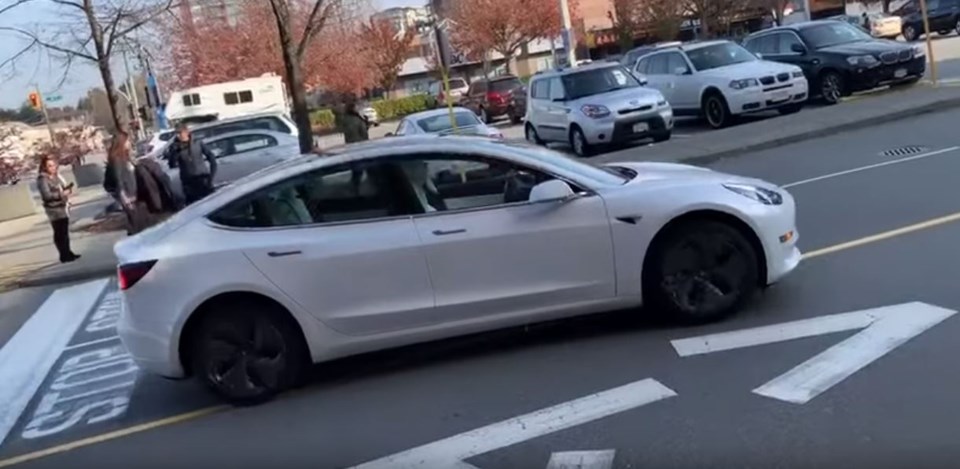The autonomous operation of vehicles, such as the Tesla incident in a Richmond shopping centre parking lot on Monday afternoon, is not permitted in B.C., according to ICBC.
ICBC released a statement Tuesday afternoon saying that the incident captured on video by a Richmond News reader - which showed a driverless Tesla coasting on the wrong side of the road in Richmond Centre - is not permitted under B.C. laws.
Had the Tesla - which was understood to be "summoned" via a mobile app by the owner up to 200 feet away - crashed, ICBC said the vehicle owner’s insurance "may not have provided coverage."
"We’re actively monitoring the development of autonomous vehicle technology here in B.C. and in other jurisdictions," the statement added.
"This is an emerging field that raises questions in regards to both safety and policy. Currently, B.C. laws do not permit driverless vehicles on our roads. A vehicle being driven autonomously in a shopping mall parking lot, for example, is not allowed. The driver is responsible for the operation of the vehicle including when driver assistance is activated."
The News reported earlier how the luxury electric vehicle was likely being “Smart Summoned” in Richmond Centre’s east lot by its owner, via new technology just rolled out in Canada.
The tech apparently allows owners to call their vehicles to their location, or a location of their choosing, within a 200-foot radius via the Tesla mobile app on their phones.
However, it doesn’t appear as if the owner in question on Monday afternoon read the instructions properly, as the driverless car entered the lot on the complete wrong side of an intersection and continued for at least 50 yards on the wrong side of the road.
A Richmond News reader, who asked not to be named, contacted the newsroom with a video she’d filmed at about 2 p.m., showing the driverless, white Tesla moving slowly through the lot.
She said a security guard from the shopping mall came outside and was chasing the driverless vehicle for a short time before a man, thought to be a friend of the owner, appeared and the car stopped.
“This is so dangerous, I’ve never seen anything like it,” the woman told the News.
She said a friend overheard the man telling the security guard that the car was being controlled remotely from a different shopping mall.
Sheila Luft, Richmond Centre’s general manager, told the News that the mall is aware of the incident and that Richmond RCMP has been contacted.
According to Tesla’s website, when the car is within 200 feet of the owner and in their line of sight, they can use a phone app to summon the vehicle in a parking lot.
Users start the car by holding down a button and stop the car by releasing it, Tesla said in instructions, warning users to be careful.
The owner needs to press and hold the “Go To Target” button to make the vehicle move. If they let go, the vehicle stops.
Teslas are equipped with sensors that enable it to detect, stop for, and maneuver around obstacles and pedestrians.
The feature has been available in the United States since earlier this year, before being rolled out in Canada last month.
But the company has not yet received approval from European authorities.
Several videos are available on the Internet, showing Tesla owners testing out the feature, with varying degrees of success, including some minor crashes.
One Tesla owner was unable to get the vehicle to approach him or even unlock the doors using the Smart Summon feature.
It turned out that he was watching the wrong silver Model 3 and didn’t see his vehicle waiting for him in the next parking row.
According to an article published by CBC last month, Transport Canada (TC) has no uniform standards for the technology.
The report said there are no TC standards that deal specifically with automation features, such as automatic emergency braking, automated steering systems and adaptive cruise control.
In the absence of formal regulations, TC has put out several documents outlining guidelines and tools for manufacturers to follow.



